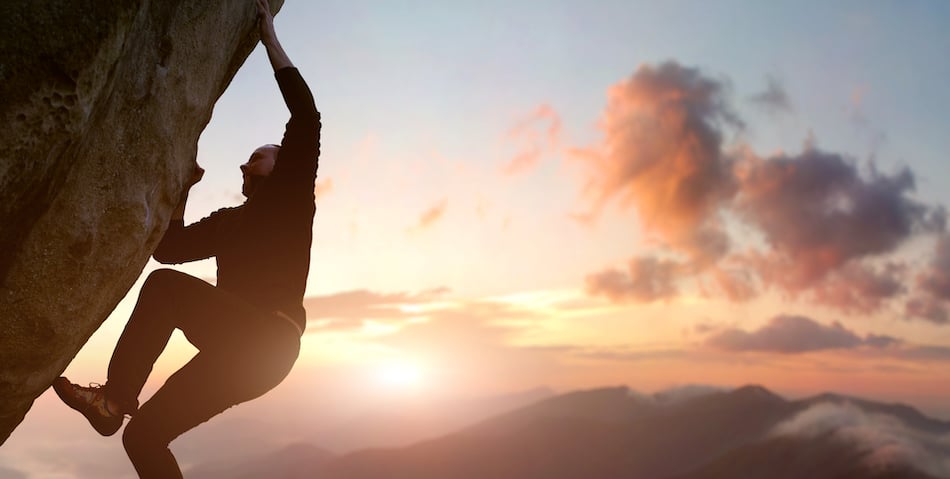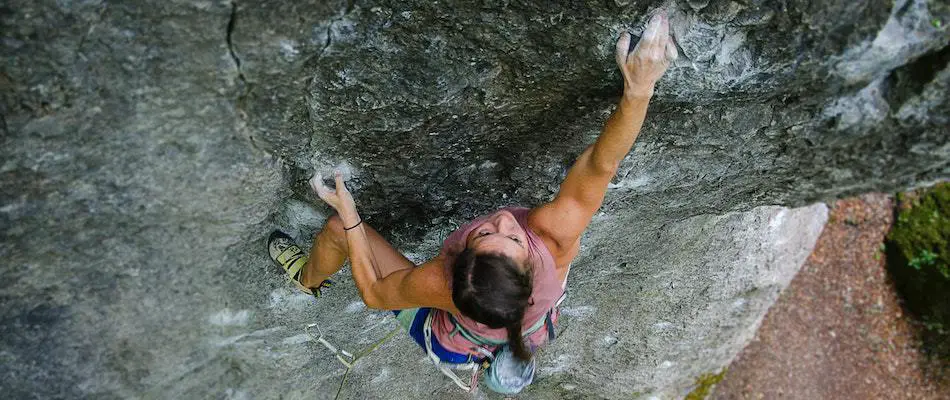
After five years of rock climbing, I spend a lot of time speaking to beginners about the sport. One of the most common questions that I get asked is what happens when a climber falls.
Most climbing falls are caught harmlessly by a rope. Occasionally, a climber will fall in a way that causes minor injuries such as bruises or concussions. Very rarely, if there’s equipment failure or the climber does not have a rope, they may die when they fall.
Falling is a very common part of climbing. In fact, the night before writing this article, I was at the climbing gym and fell several times from fifteen meters up on the wall. Nothing bad happened, because I was properly roped in and was caught safely by my belayer. However, this is not always the case. Sometimes, climbers have particularly bad falls that can lead to injuries; other times, in very rare instances, a fall may lead to death. In the rest of this article, I review three different scenarios about what happens when a climber falls.
If you want to know what stops climbers from hitting the ground when they fall, check out my article on the topic here!
When Properly Roped in and Belayed: They’re Safely Caught
This is what happens most of the time a climber falls. In fact, to see world-famous climber Adam Ondra taking some massive falls without getting hurt at all, check out the above video.
As I said, falling is a massive part of the sport, and any climber you speak to will have fallen before. It’s usually not that big of a deal, as long as they’re properly roped in and have a good belayer.
Your belayer is the person who clips themselves into the other end of the rope when you’re climbing. When you fall, they’re responsible for counter-weighting your rope so that you don’t hit the ground. Belaying is a specialized skill that requires proper training before you can do it. To avoid injury when a climber falls, they belayer needs to be sure to:
- Put the rope in their belay device in the right way
- Properly feed out the rope so there isn’t too much slack
- Watch their climber in case they fall down low, because the climber might still hit the ground
- Cushion the climber when they do fall
As you can see, belaying itself isn’t necessarily easy, but it’s a skill that anyone can learn and perform well. As long as the climber is properly tied in and belayed, they’ll fall without getting injured at all almost 100% of the time.
Roped in But Improperly Belayed: Mild to Serious Injury
The next scenario happens when the climber is properly roped in, but is incorrectly belayed. Here, because of the fact that they’re still tied into the rope, the climber most likely won’t fall all the way to the ground. However, they might swing quite violently into the wall, which can cause some serious injury.
These injuries can happen when:
- The climber climbs too far above their last bolt
- The climber improperly places gear, which comes out when they fall
- The belayer has too much slack
- The belayer has too little slack
- The climber tucks a foot behind the rope, causing them to flip over when caught
Essentially, any time the climber takes a large fall, there’s a chance that they’re going to end up injured. To see some particularly painful falls that, while still caught, likely hurt, check out this video:
As you can see, the climbers never hit the ground, but they weren’t exactly taking comfortable, controlled falls. Some of the injuries that can result from these falls include:
Whiplash: the force of a fall can jerk you quite painfully, placing a lot of strain on your back and neck. This can lead to whiplash.
Sprained or broken bones: These can occur when you swing hard into the wall and hit it with some part of your body. I’ve heard stories of sprained ankles, injured wrists, and even a shattered kneecap from climbers falling and swinging into the rock.
Concussion: Similar to above, if a climber swings head-first into the wall, they can experience some pretty severe head injuries. Most people climb wearing helmets (as they should), but even with this protective equipment, injuries can still happen.
To avoid these types of injuries, you need to make sure that you’re climbing with an experienced belayer who is always paying attention. They need to have proper rope management and know how much cushion to give you when you fall.
Additionally, you need to be careful about the type of routes you’re climbing. Some routes are denoted with an ‘r’ rating (such as 5.10r), which means risky. On these routes, even if your belayer does everything right, you risk taking a nasty fall and harming yourself. You should only climb these routes if they are well within your skill level.
Improperly Roped In: They Hit the Ground

The final, and worst-case scenario is when something goes disastrously wrong and the climber takes a ground fall. This is known as ‘decking’, and it’s every climber’s worst nightmare.
Injuries from decking can range to sprained ankles and bruises (if you fall from a relatively short distance), to broken bones and spinal damage, to death if the climber is high enough up.
So, how does a fall like this happen? There are a few ways it could occur:
- A major error by the belayer
- The climber being improperly tied in
- The climber is climbing without a rope (free soloing)
- Major equipment failure (such as the bolts coming loose from the wall)
These falls happen very rarely, and are almost entirely avoidable as long as you do everything correctly. In one famous story, world-class climber Lynn Hill forgot to tie herself into the rope and instead just looped it through her harness. After that, she failed to properly perform a partner check, so the mistake wasn’t caught. She ended up taking a 60-foot fall, hit the ground, and almost suffered life-changing injuries.
This mistake could have been avoided if she simply had her partner check her knot before she started climbing (which every climber is taught to do).
While these are the scariest falls in climbing, they’re also ones that are almost entirely avoidable as long as you have a good safety system in place. Most climbers will go their entire life without taking a ground fall.
What Injuries Can You Get from Rock Climbing?

We’ve touched a little bit on this subject, but I thought I would go into a little more detail about what injuries may occur when you rock climb.
Rock climbing injuries can vary from incredibly minor (such as scrapes, cuts, and bruises) all the way to death. The most common injuries include sprained ankles, concussions, and whiplash.
As I said, there’s a wide range of injuries you can get from rock climbing. In fact, you could basically find a way to injure any part of your body if you fall wrong. However, some of the more common injuries include:
- Blisters: rock is hard on your skin, and hands often form blisters.
- Cuts, scrapes, bruises: Caused by falls and minor slips, these heal within a week.
- Sprained ankles: If you hit the ground from a small distance, or swing hard into the wall with your ankle at the wrong angle, you can sprain it fairly easily.
- Concussions: Caused either by falling rocks or from hitting the wall.
- Tendon injuries: The tends in your fingers, shoulders, and legs are under a lot of strain when climbing, and can often end up injured.
